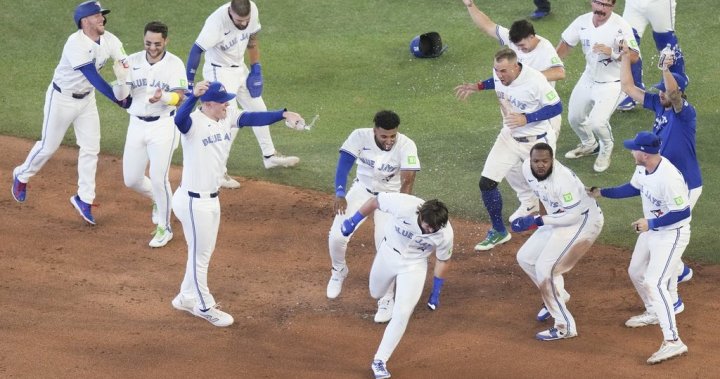The sun dipped below the Rogers Centre as I watched Vladimir Guerrero Jr. circle the bases last Tuesday, his home run ball still sailing somewhere above the left field seats. The stadium erupted in a way I hadn’t felt in Toronto since the 2016 playoff run. “This feels different,” whispered the season ticket holder beside me, a woman who hadn’t missed a home game in 27 years.
She’s right. It does feel different.
The Toronto Blue Jays’ unexpected climb to first place in the American League East this season isn’t just another baseball story—it’s a statistical anomaly, a redemption arc, and perhaps most surprisingly, a lesson in organizational patience that’s becoming increasingly rare in professional sports.
After last season’s disappointing finish, when the Jays missed the playoffs despite one of the highest payrolls in baseball, few expected Toronto to be perched atop the division standings through mid-June. Yet here they stand, with a narrow lead over their perpetual nemesis, the New York Yankees.
“We made subtle adjustments, not wholesale changes,” explains Blue Jays general manager Ross Atkins, whom I spoke with during a recent homestand. “Baseball is a game of inches, of marginal improvements. Sometimes the difference between fourth place and first is just a handful of one-run games going your way.”
The numbers tell a compelling story. Toronto’s pitching staff has lowered its collective ERA from 4.12 last season to 3.48 this year, currently the third-best mark in the American League according to Baseball Reference. The bullpen, particularly, has transformed from a liability into a weapon, with a league-leading 86% save conversion rate.
But statistics only reveal part of the picture. Walking through the concourse before games, you can feel the shift in energy among fans who’ve weathered the team’s inconsistent performances in recent years. The attendance at Rogers Centre has jumped by 17% compared to the same point last season, according to figures from the Blue Jays’ front office.
The rise hasn’t been without challenges. When I visited the team’s spring training facility in Dunedin back in March, whispers of internal discord followed an offseason of criticism. Bo Bichette and Guerrero Jr.—the cornerstones of the franchise—had faced questions about their leadership and commitment after both posted numbers below their career averages in 2023.
“People forget we’re still growing,” Bichette told me during a conversation by the batting cages. “Everyone expected us to win right away because we showed flashes early. But building a consistent winner takes time.”
That patience is paying dividends now. Guerrero has rebounded with a .321 batting average and is on pace for 38 home runs. Bichette’s defensive metrics have improved dramatically, with his Defensive Runs Saved jumping from -12 last season to +7 this year, according to data from FanGraphs.
Perhaps most crucial to the team’s rise has been the emergence of unexpected contributors. Pitcher Yariel Rodriguez, the Cuban right-hander signed to minimal fanfare last winter, has become the rotation’s stabilizing force with a 2.89 ERA across 14 starts. Rookie catcher Brian Serven, pressed into duty after injuries, has thrown out an impressive 41% of attempted base stealers while providing clutch hitting from the ninth spot in the order.
“The best teams I’ve been part of always had guys who outperformed expectations,” notes veteran pitcher Chris Bassitt, who’s experiencing a career renaissance at age 35. “Everyone talks about superstars, but championships are won by the sixth and seventh guys in your rotation, the bench players who step up when needed.”
The division race remains tight. The five AL East teams are separated by just 7.5 games—the narrowest gap of any division in baseball—with the Yankees and Orioles both within striking distance of Toronto’s perch. According to Baseball Prospectus, the Jays currently have a 61.8% chance of making the playoffs, up from preseason projections of just 43.2%.
What makes this ascent particularly noteworthy is how it contrasts with Toronto’s approach during previous competitive windows. While the 2015-16 teams relied heavily on veteran acquisitions and power hitting, this iteration has been built on defensive efficiency and pitching depth. The Blue Jays rank first in team defense according to Sports Info Solutions’ Total Defensive Runs Saved metric, a dramatic improvement from their 22nd-place finish just two seasons ago.
The front office deserves credit for architectural adjustments to Rogers Centre that have changed how the ballpark plays. The dimensions were subtly altered before the 2023 season, making it less of a hitter’s paradise and more balanced. The Jays have learned to use this to their advantage, assembling a roster that capitalizes on the stadium’s new characteristics.
As the summer progresses, the true test awaits. Toronto faces a brutal July schedule with 16 games against division rivals, including seven against the Yankees. History suggests maintaining this pace won’t be easy—the Blue Jays haven’t finished first in the AL East since 2015, and they haven’t sustained a first-place position this late in a season since 2016.
Walking back to my hotel after that Guerrero home run, I passed groups of fans still buzzing with excitement, many wearing jerseys from different eras of Blue Jays baseball—Carter and Alomar throwbacks mingling with Bichette and Guerrero shirts. There’s something poetic about Toronto’s baseball renaissance coinciding with the 30th anniversary of their back-to-back World Series titles.
Whether this year’s team can create similar October memories remains to be seen. But for now, in a city where hockey often dominates the sporting conversation, baseball has recaptured Toronto’s imagination. First place in June guarantees nothing, but it offers something every fan base craves: the permission to dream.






